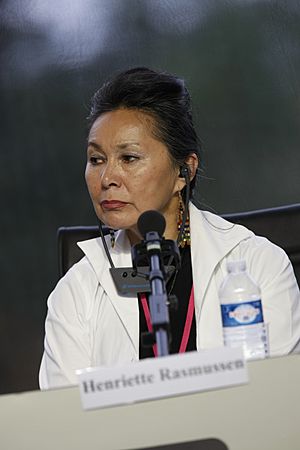Henriette Rasmussen facts for kids
Henriette Rasmussen (1950 – 2017) was an important person from Greenland. She was a teacher, a journalist, and a strong supporter of women's rights. She also became a politician. Henriette helped make sure the UN Convention on the Rights of the Child was accepted in Greenland in 1992. Later, she worked for the ILO, helping with rules for Indigenous and Tribal Peoples. She was part of the Inuit Ataqatigiit political party. She worked hard for Greenland to become independent from Denmark. From 2003 to 2005, she was Greenland's Minister of Culture and Education.
Contents
Henriette's Early Life and Education
Henriette Ellen Kathrine Vilhelmine Jeremiassen was born on June 8, 1950, in Qasigiannguit, a town in western Greenland. Her father was a skipper, and her mother worked in a factory. Henriette was the oldest of eight children. Her family taught her that boys and girls are equal. They also showed her how important education was.
When she was a teenager, Henriette spent a year in Denmark. After that, she finished high school in Nuuk, Greenland, in 1970. She then went to N. Zahle's School in Copenhagen, Denmark. In 1975, she became a qualified teacher. While studying, she became interested in the women's movement. She noticed that not many women were at the Arctic Peoples Conference in 1973.
Starting Her Career and Activism
In 1975, Henriette started teaching at a folk high school in Sisimiut, Greenland. There, she became interested in left-wing politics. She also became a leader in the new women's movement in Greenland. This included a group called KILUT, which was part of the "red stocking" movement for women's rights.
Henriette had two children, Inuk Poul and Nunni Navaranaaq, with the Greenlandic linguist Carl Christian Olsen. Together, they spent a year in Utqiagvik, Alaska. Henriette taught about Greenlandic language, books, and culture. They also helped with the 1977 Inuit Circumpolar Conference. This meeting brought together people from Siberia, Alaska, Canada, and Greenland. Henriette worked as an interpreter, helping people understand each other.
Working in Media and Politics
From 1979 to 1982, Henriette worked in the culture department at Greenland's radio station, KNR. After training as a journalist, she led the school radio and video department until 1991. During this time, she became more active in politics.
She joined the Inuit Ataqatigiit party. In 1983, she was elected as the first woman to join Nuuk's town council. She strongly supported Greenland becoming independent. In 1989, she helped three more candidates from her party get elected to the council. From 1984 to 1995, she was also a member of Greenland's parliament. There, she worked on culture, the environment, and foreign affairs. From 1991 to 1995, she was the Minister for Social Affairs and the Labour Market.
Global Work for Human Rights
Henriette Rasmussen worked hard to promote the UN Convention on the Rights of the Child. This important agreement was adopted in Greenland in 1992. In 1993, she represented Denmark at the UN World Conference on Human Rights. This year was special because it was the International Year for the World's Indigenous People.
Henriette suggested creating a permanent UN group for indigenous peoples. This idea was accepted in 1996. Because of this, she was chosen to be a Chief Technical Advisor on Indigenous People at the ILO in Geneva. She worked there until 2000. She also helped write the UNESCO World Culture Report in 1998. She became a member of the Earth Charter Commission. In this role, she helped create a global plan for the environment. She also promoted it in Greenland and through the Inuit Circumpolar Conference.
Later Years and Legacy
In 2002, Henriette Rasmussen returned to politics in Greenland. She became the Minister of Culture and Education from 2003 to 2005. After that, she went back to journalism. She was a familiar voice on KNR until she had to retire due to poor health. She also served as the French consul in Nuuk.
Henriette Rasmussen passed away in Nuuk on March 3, 2017, after a long illness. She is remembered for her dedication to education, women's rights, and the rights of indigenous peoples.


